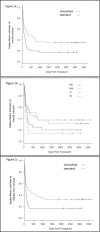The Confirmation of Safety for the Intensified Conditioning Regimens: A Retrospective Study of Allogeneic Hematopoietic Stem Cell Transplantation for Non-Remission Hematological Malignant Diseases
- PMID: 30233774
- PMCID: PMC6141425
The Confirmation of Safety for the Intensified Conditioning Regimens: A Retrospective Study of Allogeneic Hematopoietic Stem Cell Transplantation for Non-Remission Hematological Malignant Diseases
Abstract
Background: The prognosis of allogeneic hematopoietic stem cell transplantation (HSCT) for non-remission hematological malignant diseases is usually unfavorable. The most uncontrollable factor is residual disease or relapse. To overcome this problem, intensified conditioning regimens- sequential and/or additional chemotherapy to the standard regimen- could be effective. However, increasing the intensity of conditioning might also lead to more complications. Materials and Methods: We retrospectively analyzed 81 patients with non-remission disease who received allogeneic HSCT in our institution between 2007 and 2011. Results: 55.6% in 36 myeloablative conditioning patients and 46.7% in 45 reduced-intensity conditioning patients received intensified conditioning. The 5-year probability of overall survival was 35.0% and 17.1% in the standard and intensified group, respectively (p=0.027). Relapse mortality was 30% in the standard regimen group and 36.6% in the intensified regimen group (p=0.54). Transplant-related mortality (TRM) at 30 and 100 days was 5%, 17.1% (p=0.086) and 27.5%, 34.2% (p=0.52) in the standard and intensified group, respectively. There was no difference in TRM between the 2 groups at 30 days and 100 days. Conclusion: The results of the study confirm the safety of the intensified conditioning regimen. Meanwhile, it could be considered as one of the few methods available to reduce the tumor burden before HSCT for refractory malignant diseases.
Keywords: Allogeneic hematopoietic stem cell transplantation; Intensified conditioning; Non-remission diseases; Sequential and additional chemotherapy.
Figures


Similar articles
-
Thiotepa-Based Intensified Reduced-Intensity Conditioning Adult Double-Unit Cord Blood Hematopoietic Stem Cell Transplantation Results in Decreased Relapse Rate and Improved Survival Compared with Transplantation Following Standard Reduced-Intensity Conditioning: A Retrospective Cohort Comparison.Biol Blood Marrow Transplant. 2018 Aug;24(8):1671-1677. doi: 10.1016/j.bbmt.2018.04.019. Epub 2018 Apr 21. Biol Blood Marrow Transplant. 2018. PMID: 29684565
-
Idarubicin-intensified BUCY2 conditioning regimen improved survival in high-risk acute myeloid, but not lymphocytic leukemia patients undergoing allogeneic hematopoietic stem cell transplantation: A retrospective comparative study.Leuk Res. 2016 Jul;46:61-8. doi: 10.1016/j.leukres.2016.04.014. Epub 2016 Apr 19. Leuk Res. 2016. PMID: 27131062
-
Conventional versus reduced-intensity conditioning regimen for allogeneic stem cell transplantation in patients with hematological malignancies.Eur J Haematol. 2005 Feb;74(2):144-51. doi: 10.1111/j.1600-0609.2004.00360.x. Eur J Haematol. 2005. PMID: 15654906
-
Allogeneic hematopoietic stem cell transplantation in adult acute lymphoblastic leukemia: potential benefit of medium-dose etoposide conditioning.Exp Hematol Oncol. 2015 Jul 16;4:20. doi: 10.1186/s40164-015-0015-0. eCollection 2015. Exp Hematol Oncol. 2015. PMID: 26322249 Free PMC article. Review.
-
Alloreactivity as therapeutic principle in the treatment of hematologic malignancies. Studies of clinical and immunologic aspects of allogeneic hematopoietic cell transplantation with nonmyeloablative conditioning.Dan Med Bull. 2007 May;54(2):112-39. Dan Med Bull. 2007. PMID: 17521527 Review.
References
-
- Gratwohl A, Brand R, Frassoni F, et al. Cause of death after allogeneic haematopoietic stem cell transplantation (HSCT) in early leukaemias: an EBMT analysis of lethal infectious complications and changes over calendar time. Bone Marrow Transplant. 2005;36(9):757–69. - PubMed
-
- Ringden O, Labopin M, Schmid C, et al. Sequential chemotherapy followed by reduced-intensity conditioning and allogeneic haematopoietic stem cell transplantation in adult patients with relapse or refractory acute myeloid leukaemia: a survey from the Acute Leukaemia Working Party of EBMT. Br J Haematol. 2017;176(3):431–39. - PubMed
-
- Chang C, Storer BE, Scott BL, et al. Hematopoietic cell transplantation in patients with myelodysplastic syndrome or acute myeloid leukemia arising from myelodysplastic syndrome: similar outcomes in patients with de novo disease and disease following prior therapy or antecedent hematologic disorders. Blood. 2007;110(4):1379–87. - PMC - PubMed
-
- Avivi I, Canals C, Vernant JP, et al. Matched unrelated donor allogeneic transplantation provides comparable long-term outcome to HLA-identical sibling transplantation in relapsed diffuse large B-cell lymphoma. Bone Marrow Transplant. 2014;49(5):671–8. - PubMed
LinkOut - more resources
Full Text Sources
